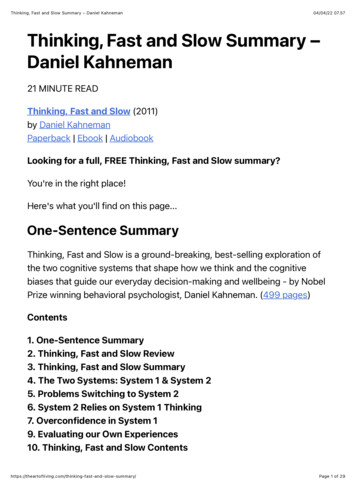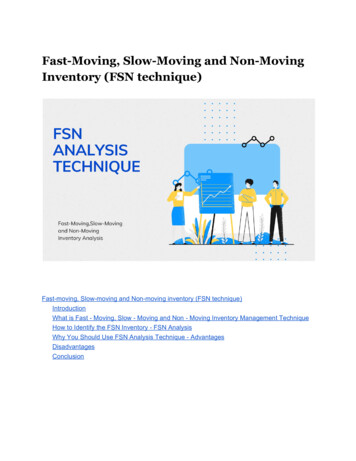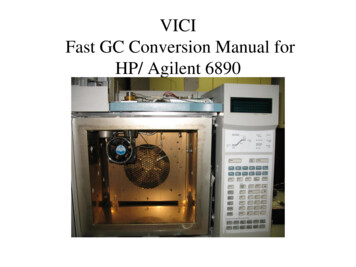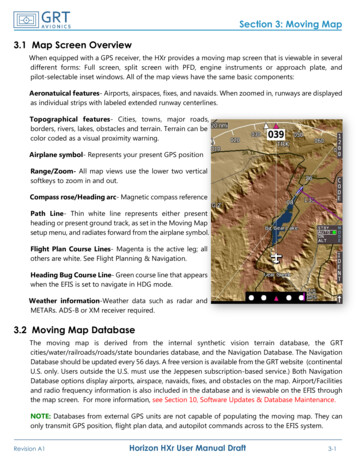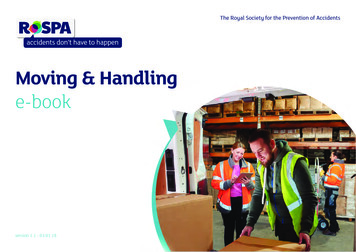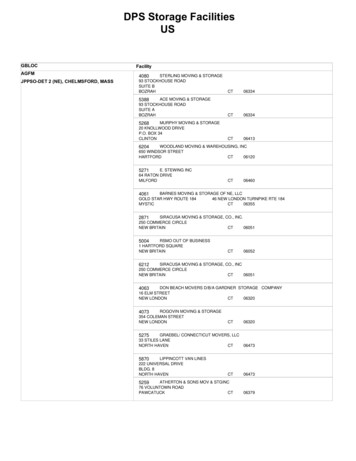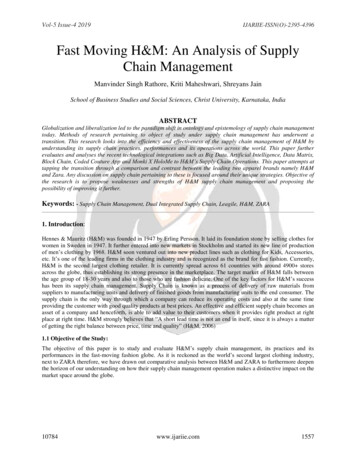
Transcription
Vol-5 Issue-4 2019IJARIIE-ISSN(O)-2395-4396Fast Moving H&M: An Analysis of SupplyChain ManagementManvinder Singh Rathore, Kriti Maheshwari, Shreyans JainSchool of Business Studies and Social Sciences, Christ University, Karnataka, IndiaABSTRACTGlobalization and liberalization led to the paradigm shift in ontology and epistemology of supply chain managementtoday. Methods of research pertaining to object of study under supply chain management has underwent atransition. This research looks into the efficiency and effectiveness of the supply chain management of H&M byunderstanding its supply chain practices, performances and its operations across the world. This paper furtherevaluates and analyses the recent technological integrations such as Big Data, Artificial Intelligence, Data Matrix,Block Chain, Coded Couture App and Monki X HoloMe to H&M’s Supply Chain Operations. This paper attempts attapping the transition through a comparison and contrast between the leading two apparel brands namely H&Mand Zara. Any discussion on supply chain pertaining to these is focused around their unique strategies. Objective ofthe research is to propose weaknesses and strengths of H&M supply chain management and proposing thepossibility of improving it further.Keywords: - Supply Chain Management, Dual Integrated Supply Chain, Leagile, H&M, ZARA1. Introduction:Hennes & Mauritz (H&M) was founded in 1947 by Erling Persson. It laid its foundation stone by selling clothes forwomen in Sweden in 1947. It further entered into new markets in Stockholm and started its new line of productionof men’s clothing by 1968. H&M soon ventured out into new product lines such as clothing for Kids, Accessories,etc. It’s one of the leading firms in the clothing industry and is recognized as the brand for fast fashion. Currently,H&M is the second largest clothing retailer. It is currently spread across 61 countries with around 4900 storesacross the globe, thus establishing its strong presence in the marketplace. The target market of H&M falls betweenthe age group of 18-30 years and also to those who are fashion delicate. One of the key factors for H&M’s successhas been its supply chain management. Supply Chain is known as a process of delivery of raw materials fromsuppliers to manufacturing units and delivery of finished goods from manufacturing units to the end consumer. Thesupply chain is the only way through which a company can reduce its operating costs and also at the same timeproviding the customer with good quality products at best prices. An effective and efficient supply chain becomes anasset of a company and henceforth, is able to add value to their customers when it provides right product at rightplace at right time. H&M strongly believes that “A short lead time is not an end in itself, since it is always a matterof getting the right balance between price, time and quality” (H&M, 2006)1.1 Objective of the Study:The objective of this paper is to study and evaluate H&M’s supply chain management, its practices and itsperformances in the fast-moving fashion globe. As it is reckoned as the world’s second largest clothing industry,next to ZARA therefore, we have drawn out comparative analysis between H&M and ZARA to furthermore deepenthe horizon of our understanding on how their supply chain management operation makes a distinctive impact on themarket space around the globe.10784www.ijariie.com1557
Vol-5 Issue-4 2019IJARIIE-ISSN(O)-2395-43962. H&M’s “Design, Production & Distribution”:H&M is prominent for offering fashionable, modish styles apparels and accessories with rapid change over. H&Mensures the best customer offering in every market by maintaining the right pieces of stock in each store that willbest suit the customer preferences. H&M strives to provide varied range of merchandise that incentivizes customersto both browse and shop passionately.According to (Lu, 2014) H&M is headed by the team of 100 skillful, polished and artistic designers designing theircraft from H&M design center in Stockholm, Sweden widely known as “White room”. The designers diligently planand produce season after season collections accomplishing its two-fold design process through long term planning ofcollections which is done more than a year in advance and real time design feedback that stems out of a customerdriven product strategy. The teams responsibly and meticulously do the flexible assortment planning to ensure thatevery store feels updated on trends and patterns of the merchandise as the demographics and geography significantlyinfluences the distribution of the merchandise. Therefore, high fancy apparels are significantly produced in smallquantities and mainly distributed to the main big cities whereas, essentials are ordered in bulk and are widelydistributed around the globe. Furthermore, H&M closely work with enthralling number of services to produceassorted range of merchandise there about, H&M has 80- pattern makers, 800 - suppliers and 30- productiondistribution centers to be precise across the globe making H&M the world’s second largest clothing retailer(MUÑOZ, 2015).Henceforth, H&M core operation heavily relies on its profound designers, creative directors and pattern makers tostay on top of the game, therefore, H&M has wisely invested on their extremely talented, highly proficient anddiverse workforce around the globe, coming from japan, Holland, japan and many more together to produce theright mix of article and accessories and many other different products of H&M to catch up with the latest trends,colors and reasonable prices and fit of the merchandise to suit their customers interests using the service of WorthGlobal Styles Network (WGSN) to forecast fashion trend and patterns in current times (PETERSON, 2014).2.1 Manufacturing:The key to H&M success has been its Dual Integrated Supply chain. In simple words, dual integrated supply chainmeans having two sources of suppliers producing the same products for the company (MUÑOZ, 2015). H&M hasheavy dependence on outsourcing from design to production which is H&M’s most commendable and admirablecharacteristic i.e. its ability to effectively and efficiently collaborate with its partners around the globe. Having statedthat, not having factories of its own, H&M utilizes over 800 partner companies in more than 30 countries, that isH&M’s 60% of the merchandises are manufactured by the Asian countries majorly in Bangladesh, VietnamCambodia, India and China. Hence, rest are manufactured by the European suppliers (Lu, 2014).H&M is mainly integrated with three types of suppliers divided into categories namely: Platinum & Gold, Silver &Other Suppliers (Suppliers List: H&M, 2018) Platinum & Gold:The suppliers under this category are mainly the preferred suppliers. The produce around 60 % of the products. Onlythe suppliers with the best performance and who focus more on sustainability fall under this category. Silver:The suppliers that fall under this category are those with which H&M works on a long-time basis and with thosewho develop close relations with. H&M even provides training and room for development to these suppliers. Other:The suppliers under this category have are in the initial stages of production for H&M or with whom H&M has justplaced a test order for its operation. It is difficult for the company to trust on these suppliers and therefore only onthe basis of analysis, the suppliers move up the order.Fashion industry is appropriately acknowledged as ‘fast fashion’ as it requires higher degree of flexibility,adaptability and response to production and decision making. Therefore, H&M integrates both lean and agileprocess of manufacturing to reap the maximum benefits out it. In Lean production products take lower lead time asbasic and specific merchandises are produced for its customers with large volumes and low variability (MUÑOZ,10784www.ijariie.com1558
Vol-5 Issue-4 2019IJARIIE-ISSN(O)-2395-43962015). Lean production is product oriented and aims at cost optimization, elimination of wastages and efficiency.Whereas, in agile production products take higher lead time as they are fashion sensitive apparels and are madeavailable at very short notice using market knowledge and virtual corporation while maintaining the high standardsof quality and controlling the overall costs involved in the production. Lean production aims to provide highercustomer satisfaction with higher flexibility variety and effectiveness. In the H&M supply chain process, the leanmanufacturing is done by the Asian suppliers which accounts 60% of the production and agile manufacturing isdone by the European suppliers which is the rest of the production (Saini, 2007).Source: (Saini, 2007)H&M collections are created and placed centrally in the design and buying unit to bring about the balance of majorthree components i.e. fashion, quality and best price. Though H&M does not own any manufacturing units, but ownsthe production of offices and closely with its partners to ensure the safety and quality of the product. As H&Moutsources most its supplies from Asia to achieve the advantage of leanness the lead time varies 2 weeks to 6months. Asian Manufacturers procure fabric in advance as per the forecast in order to minimize the cost and increasethe efficiency. The production office of H&M is situated in the origin of the production to ensure the quality andwork standards of the suppliers maximize the efficiency, minimize the lead time, achieve the lowest cost and zerodefects in the given time frame. The transit point in the Hamburg warehouse works as a decoupling point wheredemands shifts from pull to push, while managing the flow of goods and information upstream and downstream. AsH&M is ever evolving, customer centric company and striving to learn from its customers, its focuses on attaininghigher customer satisfaction by serving the surge demand by production in the Europe. Henceforth in this way,H&M brings price and quantity advantage by achieving ‘leagile’ (Lean Agile) in its supply chain operation(MUÑOZ, 2015).2.2. Transport Management at H&M:To ensure that the products get delivered to the customers just in time or to get the products available in storesbeforehand, it is crucial for H&M to choose the cheapest and fastest route plan. The final product manufactured bythe supplier is generally sent to the warehouse in Hamburg, Germany from where it is ensured that the products aremade available in stores but in situations where the demand is design specific, H&M ensures that the produce isdirectly transported to the particular location of the country ensuring that it is made available just in time. H&Mdoes not depend on third party for its logistics and uses its own logistics services in the name of “H&M InternationalTransportation, Inc.” H&M mainly uses Railways, Waterways and Roadways as their mode of transportation to10784www.ijariie.com1559
Vol-5 Issue-4 2019IJARIIE-ISSN(O)-2395-4396deliver the products across the globe, thus making it cost effective as well (MUÑOZ, 2015). But when there is asurge demand of new trends, the preferred mode of transport is usually Airways.Suppliers: AsiaEuropeMain WarehouseHamburg, GermanyDistributionCentres:Northern EuropeStoresSouthern EuropeFirstly, the production produce from suppliers in Asia or Europe are transported through Ship to the main warehousein Hamburg, Germany. In case of urgency, airways are preferred over waterways. Although, most part of theproduction comes from the Asian suppliers, the goods need to be transported to the main hub in Hamburg. Thegoods received in Hamburg are then transported through Rail to the distribution centers in the specific geographicarea. Once the merchandise reaches the distribution centers, they are then sent to the stores through trucks or rail.The distribution centers are often located nearby to the stores which makes transportation easier. For example:Poznan Distribution Centre is totally based for Northern European Market.H&M has a distribution center established in most of the countries it operates in. There are currently around 13distribution centers in Asia and Europe (. Stockholm, the headquarter of H&M logistics department, is in charge ofimporting products, managing stocks and distribution of supplies to the distribution centers. For instance, if H&Mwants to expand its operations to a new country, it initially does not set up a distribution center over there but ratherit uses the distribution center which is closely situated to that country, thus saving the initial costs of establishment.When the supplies arrive in each of the distribution centers, the supplies are then unpacked and then they undergo aquality test. Depending on the demand, the supplies are then delivered to each of the stores or are stored in a call offwarehouse (a place in each distribution center for storage of goods). Moreover, H&M does not have any backupstocks; they are only replenished from the call off warehouse. As soon as the stock gets over, a replenishmentrequest is sent. For example, H&M has distribution centers set up in Sweden (Boras DC) and Poland (Poznan DC)respectively. (Munoz, 2015: 23)Replenishment in Poznan DC:The Poznan Distribution Centre receives the supplies from most of the suppliers situated in Asian and theTurkish market. The produces arrived in Poznan distribution center are done via catalogues accordingly to ensurethat the distribution center has sufficient stock to match the customer demand (MUÑOZ, 2015).Replenishment in Boras DC:The transportation of supplies to Boras Distribution Centre occurs in a rare situation. Most of the suppliesreceived in Boras DC are transported from Poznan DC. For instance, the Boras distribution center is suppled directlywith the produce only when the produce is more than enough to fill a container or when the supplier is situatednearby to the distribution center. An another significant reason for why the produce could be directly supplied to theBoras DC is when the product is to be sold in Scandinavian region (MUÑOZ, 2015).The distribution center in Boras DC undergo the sales forecasting to predict the supplies for the next two weeksrespectively. The distribution center then requests for relocation of goods from the distribution center in Poznan.10784www.ijariie.com1560
Vol-5 Issue-4 2019IJARIIE-ISSN(O)-2395-4396The system then compares the request with the past replenishments and accordingly the forecast is made for theseason and finally the replenishment of goods is sent to Boras DC (MUÑOZ, 2015).To summarize:Demand atBoras DC fornext 2 weeksforecasted.Request forreplenishmentof goods byBoras DCComparisonand SeasonalForecastRequest forrelocation atBoras DCReplenishment ofgoods sent atBoras DCDemand atPoznan DC fornext 2 weeksforecastedSource: (MUÑOZ, 2015)The distribution process at H&M comparatively takes more time to reach the stores than its competitor. Forexample: ZARA, the leading firm in this field, can transport up to 1 million items per week and takes a lead time of14 days from the designing of product to making it available in stores. H&M does the same in 21 days. The supplychain of H&M Is comparatively longer mainly due to the transportation of production produce to the warehouse inGermany before finally transporting it to the distribution centers.2.3 Inventory Management at H&M:H&M follows both Centralized and Decentralized Inventory Management System. Some of the activities carried outwhile managing inventory are centralized such as Quality Inspections & excess stock keeping. This helps them frompreventing excessive damages as professional inventory managers are hired for these tasks. Whereas, in some casesH&M carries decentralized form of inventory management system. This is mostly done only in the regional marketin order to cater to the needs of the local customers and also helps them manage inventories effectively. Followingthe decentralized system helps H&M to develop a good customer relationship. Moreover, H&M stores do not keepback up stocks. However, once the stock is sold out, a request for replenishment of goods is placed and products aredelivered from the regional replenishment centers.According to the Annual Report of H&M 2018, it had an excess inventory of around 4.3 Billion and H&M believesthat digitalization up to a great extent can help them remove the inventory. H&M has now initiated RFID (RadioFrequency Identification) in almost 1800 of the stores of H&M and plan to initiate it in many other stores (JamieGrill-Goodman,2018). Moreover, they believe that a new venture may take off the load of the excess inventory andtherefore they have come up with Afound in 2018 which is an off-price marketplace which would sell products offashion and lifestyle. H&M has also introduced automated warehousing system in most of the warehouses. Theautomated logistics centers help in increasing efficiency and capacity up to a great extent, thus resulting in a shorterlead time (Grill-Goodman, 2018).2.4. Warehouse Management at H&M:H&M’s central warehouse which is located at Hamburg, Germany acts as a main hub for all the production ofmerchandise. The total production from all the suppliers in Asia & Europe respectively are first transported to thecentral warehouse. H&M highly relies on Information Communication Technology (ICT) to prevent damagescaused by excessive production. Generally, the products are transported to the central warehouse but in cases wherethe demand is design specific or the produce is for the regional markets, H&M through the use of ICT makes surethat the produce is directly delivered to the particular country or region. The central warehouse of H&M receivesmore than 160 million pieces on a daily basis and therefore the warehouses is designed in a way so that it couldhandle a large amount of deliveries at a time. (MUÑOZ, 2015)10784www.ijariie.com1561
Vol-5 Issue-4 2019IJARIIE-ISSN(O)-2395-43963. How is H&M tackling with the un-certainty of Demand?Demand forecasting in supply chain operation plays a vital role in deciding the efficacy of a firm. If a company cannotpredict the demand of a product in a right manner it will surely result in wastage of resources, leading to higher inventories,high labor cost, improper usage of operational areas etc. In fashion industry forecasting of demand can be difficult comparedto other industries since in fashion industries product takes longer lead time, has uncertain customer’s demand, short sellingseasons.Forecasting demand is a big challenge for a company. Right proportion of balance between requirement of customers andproduction capacity is considered as one of the primary objective of managing the Supply chain of a company. When acompany operates its supply chain, it has to go through certain dynamics which create changes in both production rates andinventory level commonly knowns as Bullwhip Effect which brings about distortion in one’s supply chain. Here BullwhipEffect refers to a phenomenon where disparity of demand expands dramatically since every order has to go through everylevel of company’s supply chain.H&M has considered its supply chain as a single entity which help them to cater to their actual demand of a product. H&Mthoroughly study’s the end user demand data instead of forecasting demand based on orders received. H&M keeps an eye onuncertain events which might interrupt the manufacturing process in future so they keep their Buffer inventory ready whichwill not hurt production or sales. Buffer is determined by the unforeseen events in market demand and service required by themarket. Company like H&M believes that if they share a company’s forecasting data through all levels in Supply Chainsfrom POS (Point of Sales), it will lead to a longer way in reduction of uncertainty extensively.Source: (MUÑOZ, 2015)H&M uses the integral focus of QR which help them to manage their inventory management smoothly and efficiently. Thishelps H&M to keep proper balance between supply and demand of a product. QR consist of a uniform set of Bar codes,Labels, Electronic Data Exchange messages, etc. integration of QR helps H&M in sharing Information data smoothly withtheir partners that leads to an efficient and effective Supply Chain management. H&M uses QR for their highly volatiledemanded products, a long resupply time and a product with short life cycle (MUÑOZ, 2015).H&M also uses the data from their retail stores(POS) in forecasting the demand of certain products which arefavorites among customers. H&M always try to fulfill their customer’s demand effectively and efficiently and alsotries to eliminate distortion in its supply chain and keeping themselves well versed with current fashion seasons.4. H&M - Technological IntegrationIntroduction of latest technologies and artificial intelligence in supply chain operation makes a company stable andcompetitive in the market place. Company that has introduced latest techniques in their operational business aregetting the benefit of lower-cost in manufacturing goods, less lead time, efficiently gathering data of customer’spreferences, efficient usage of transportation facilities and keeping the goods in better condition in latest advancedwarehouses. H&M, world’s second largest fast fashion retailers are growing at a rapid speed in expanding theirmarket in fashion industry. Through digitization and technological integration H&M are fulfilling customer’sdemand effectively and efficiently considering their affordability, personalization of the product, latest fashiontrends, fast delivery process and furthermore (Assignments: Digital Initiative, 2016). H&M has integrated AItechnologies and advanced data analytics that helps them in Demand forecasting, less lead time, better inventory10784www.ijariie.com1562
Vol-5 Issue-4 2019IJARIIE-ISSN(O)-2395-4396management, improving connection with customers, adjusting themselves with the latest trends in fashion industriesto be at top of the game.Here are some of the successful tech H&M has recently integrated in their Supply chain management:1.Big data and Artificial Intelligence- H&M has around 4000 stores throughout the world. Whether yougo to the Sweden, Spain and India, you’ll find similar merchandise in every store of H&M. Sometimes thisdoes not go well with the taste of customers since company fails in studying the latest trend of fashion andultimately it results in mass production. Mass production forces the retailers to cut down the price of someproducts. In order to fulfill customer’s demands based on their cultural background; H&M came up with aneffort to better stock individual stores. H&M is integrating AI and Big data to get the trust of their existingcustomers by introducing Loyalty card data, analyzing returns, marinating the memo and receipts of thesame. Through these ways H&M is able to tailor its merchandise for each store (Marr, 2016).2.Automated Warehouses- Apparently H&M is using EPC (Electronic product code) in the form of RFIDas a tool to identify the data and location of any product kept in a warehouse. A particular product has aunique digital price tag which help a firm in finding out its location quickly and efficiently. RFID helpsretailers in finding out the past 2 years’ stocks units to weekly or even to daily stock counts. RFID helpsH&M in conducting correct demand forecasting in turn its lead to higher profitability. RFID tag can beused anywhere in the world which makes it valuable for any firm. Also, through RFID technology H&M isable to connect with customers in the best possible way. They are making easier for customers by workingon better online-offline shopping experience. For instance: Find a store feature help the customers infinding out whether a product is available in offline H&M stores or through scanning an in-store label,customers can see whether a product is available in other online/offline stores or not (Marr, 2016).3.Data Matrix- H&M has recently come up with 2D barcode that looks like pixelated rectangle. Thisbarcodes stores a significant amount of data. It carries both numbers and letters. Altogether it can store upto 2335 characters’ limits. Basically data matrix shows the supply chain data such as batch numbers,product certification, helps in tracing the small products. H&M also use this tool in camera scanners to readat POS. Data matrix also include URL which means it can be used to support online digital service offers(Industry News: The Global Language of Business, 2019).4.Coded Couture App- Google and H&M together came up with the coded couture app which is a part ofH&M’s fashion designing house Ivyrevel. This app helps a customer in finding an appropriate dress he/shewants to wear for an occasion or for any casual event, hassle free. Here Android’s awareness API willcheck on user’s daily routine like where they prefer to eat, what’s the weather condition in their locality,whether they have to attend a formal or casual meeting, is it for a birthday or marriage events, etc. all thisvital information is passed through a channel or algorithm to the app which tailors the outlook of the dressto their customers that fits them the best (Marr, 2016).5.Monki x HoloMe- H&M group’s Monki has collaborate with Holome to make the customers experiencewith high definition Human Holograms virtual reality. This will be experience through both smartphoneand tablet with not much data usage. Here, app will showcase 9 Hologram with different outfits to the userswhich will allow users to observe keenly and let them decide with what distinctive look they should go for.This 3D effect of apparels will make the customers believe that the holograms are standing in front of themand giving them a virtual experience therefore, inspiring the customers to shop wisely (Halliday, 2018).6.Home stylist- H&M’s home stylist has collaborated with Google and through the help of google assistantcustomers can ask to connect them with H&M Home Stylist which will suggest the latest styling advices,mood board, nearby shops and retailers to the customers. This technology would be the first voiceapplication app to be introduced within the fashion industry. App will also provide choice of preferablevoices, whether you want an exclusive human male or female voice to be able to articulate thecommunication in an effective manner making shopping easier than ever before (IRIBARREN, 2018).10784www.ijariie.com1563
Vol-5 Issue-4 20197.IJARIIE-ISSN(O)-2395-4396Blockchain- H&M’s subsidiary Arket has confirmed that they are going to test some new product throughblockchain technology. Here Arket can trace the data of the product and make it sure that data does not getleaked outside. Blockchain is a trusted tool for H&M to keep their data secured. Each block in a blockchainare put in such a manner that they are stored in linearly and chronological order since they are added to theend of a blockchain. Each block has a unique hash code which is made through math function. Hash codekeep transform the digital information in the form of numbers and letters. This is one of technologies thatH&M is looking forward to integrate with its supply chain to yield some benefits out of it such as:eliminating the risk of forgery and errors, reducing courier cost, identification of any issues quickly,building consumer and its partners trust, minimizing delays in paper works and resulting in advanceinventory management (Mix, 2018).5. ZARA Vs H&M: Who does it better?ZARA being the king in the Apparel Industry followed by H&M, therefore, comparison of ZARA and H&M is ofgreat significance in evaluating their supply chain operations throughout the world.BasisZARAH&MMarketsAround 2200 stores in 96 countriesAround 4968 stores in 61countries.Supply ChainVertically Integrated Supply ChainDual Supply ChainOutsourcing or OwnProduction HouseOwns Production ActivitiesOutsources its ProductionActivities to its suppliers.Major ProductionProduction is mainly done in Spain &PortugalProduction is mainly done in Asia& Europe continentsModes Of TransportUses Fastest Mode Of Transportation (Planes,Trucks); Also owns Railway tracksUses cheapest modes of transport(Waterways, Railways, Roadways)Distribution ChannelCentralized Distribution SystemCentralized plus Local DistributionSystem10784www.ijariie.com1564
Vol-5 Issue-4 2019Lead TimeIJARIIE-ISSN(O)-2395-4396As less as Two WeeksIn Asia- 3 monthsIn Europe- 3 weeksInventory ManagementCentralized Inventory Management SystemFollows Centralized as well asDecentralized ManagementSystemLogisticsThird Party Logistics Provider (3PL)-In house Logistics Provider-Inditex LimitedH&M International Transportation,Inc.ZARA, the leading firm in the Apparel Industry and also the youngest one, is spread across 96 countries with around2200 stores spread across these countries. ZARA’s Supply chain is designed in such a way that a product could bedesigned and have the same product sold in the store a month later. Whereas H&M, the 2 nd leading firm in theApparel Industry and the oldest one, is spread across 61 countries with around 4968 stores spread across. ZARAfollows a Vertically Integrated Supply Chain where it manages its own supply chain, that is, the whole process istotally run by them whereas H&M follows a Double Integrated Supply Chain where there are more than onesuppliers for the company. ZARA owns its production activities and is solely responsible for its outcomes whereasH&M outsources its production activities to suppliers and there are high chances of delay in the production process.ZARA uses the fastest mode of transportation to get the first mover advantage whereas H&M focuses more on costcutting and therefore uses the cheapest mode of transportation, thus reducing the chances of getting the advantage.ZARA uses Centralized Inventory Management System in order to ensure the best for the customers at any costwhereas H&M uses Centralized as
the horizon of our understanding on how their supply chain management operation makes a distinctive impact on the market space around the globe. Vol-5 Issue-4 2019 IJARIIE -ISSN(O) 2395 4396 10784 www.ijariie.com 1558 2. H&M's "Design, Production & Distribution": H&M is prominent for offering fashionable, modish styles apparels and .
